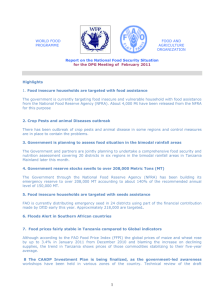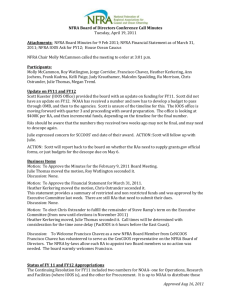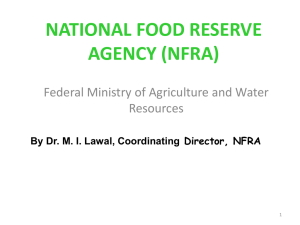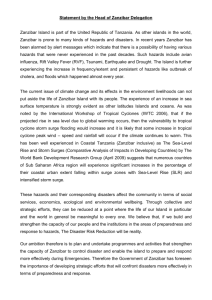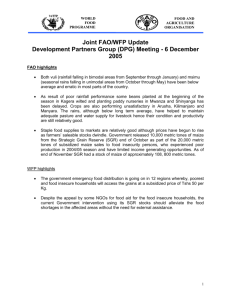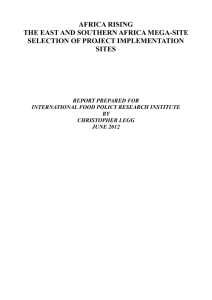WORLD FOOD PROGRAMME
advertisement
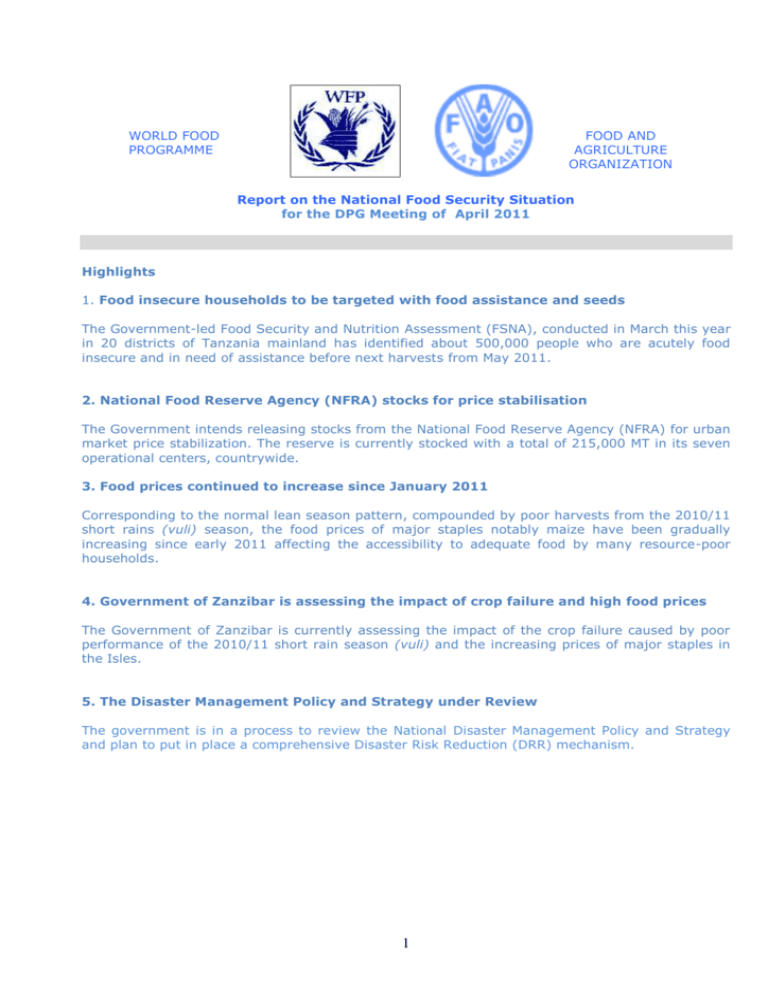
WORLD FOOD PROGRAMME FOOD AND AGRICULTURE ORGANIZATION Report on the National Food Security Situation for the DPG Meeting of April 2011 Highlights 1. Food insecure households to be targeted with food assistance and seeds The Government-led Food Security and Nutrition Assessment (FSNA), conducted in March this year in 20 districts of Tanzania mainland has identified about 500,000 people who are acutely food insecure and in need of assistance before next harvests from May 2011. 2. National Food Reserve Agency (NFRA) stocks for price stabilisation The Government intends releasing stocks from the National Food Reserve Agency (NFRA) for urban market price stabilization. The reserve is currently stocked with a total of 215,000 MT in its seven operational centers, countrywide. 3. Food prices continued to increase since January 2011 Corresponding to the normal lean season pattern, compounded by poor harvests from the 2010/11 short rains (vuli) season, the food prices of major staples notably maize have been gradually increasing since early 2011 affecting the accessibility to adequate food by many resource-poor households. 4. Government of Zanzibar is assessing the impact of crop failure and high food prices The Government of Zanzibar is currently assessing the impact of the crop failure caused by poor performance of the 2010/11 short rain season (vuli) and the increasing prices of major staples in the Isles. 5. The Disaster Management Policy and Strategy under Review The government is in a process to review the National Disaster Management Policy and Strategy and plan to put in place a comprehensive Disaster Risk Reduction (DRR) mechanism. 1 1. About 500,000 people are food insecure and in need of short-term assistance The Government under the umbrella of the MUCHALI (Mfumo wa Uchambuzi wa Uhakika wa Chakula na Lishe) Tanzania, conducted a food security and nutrition assessment in 20 districts in six regions in March 2011 to establish the impact of the failure of the short rains “vuli” and other factors on food security Map1: Food Security and Nutrition Situation and nutrition of the people. The overall results established that 494,078 people (7% of most affected population) are acutely food insecure with very low resilience, whereas 865,420 people are moderately food insecure. Access to food for these 865,420 people is likely to remain fairly adequate until end of May 2011 when their physical stocks and their other means for accessing food will be running low. The assessment report recommends that the government consider distributing 11,858 MT of food assistance to the affected population in bimodal areas and a total of 3,603 MT in unimodal areas as an immediate intervention for the period between April – May 2011. Out of this amount, 1,570 MT are recommended for free distributions to 79,434 chronically food insecure population and the remaining 11,057 MT for subsidized prices for people, who cannot afford to buy food at market prices. 2. The emergency (NFRA) stocks for price stabilization in urban areas. The Government will release maize from its emergency stocks through the National Food Reserve Agency (NFRA) for price stabilization in major urban centers. This decision has been taken to address the current high prices on major staples notably maize, which has reduced access to food by low income food insecure households. The Ministry of Agriculture Food Security and Cooperatives (MAFC) through the NFRA and the Food Security Department are working out modalities to implement the price stabilization plan. One option would be targeting the middle level millers as most urban consumers prefer maize meals. The need to assess the capacity of the millers in terms of milling, packaging and distribution network is a crucial element of this intervention strategy. During the 2010/11 market year, the Government through the NFRA has been building its emergency reserve to 215,000 MT, recording over 40% above the recommended level of 150,000 MT. The stocks are prepositioned in the NFRA’s seven (7) strategic locations of Arusha, Dar es Salaam, Songea, Makambako, Dodoma, Sumbawanga and Shinyanga. 2 3. Availability of Staple Foods and Food Prices Food Prices have been gradually increasing since January this Year as the period coincides with the lean season when stocks draw down, compounded by high fuel prices and general inflation in the country. Between January and March this year, nominal wholesale prices of maize in the selected urban markets in Tanzania remained lower than the same period in 2010 indicating adequate availability of food supplies from the good 2009/10 main harvests compared with the 2008/09 production season. In March 2011, prices of maize, an important staple in the country, decreased by 9-12% in Arusha, Dodoma and Shinyanga markets over those of 2010 but were higher than their 2006-10 averages in Arusha (14%), Dar es Salaam (26%), Dodoma (16%); and Shinyanga (20%). However, those prices are showing an upward trend since January this year, driven by anticipated poor harvests from the concluded short rains (vuli) season. 4. The Government of Zanzibar is assessing the impact of crop failure on food security Following the poor performance of the short rains in many parts of Zanzibar and the current high food prices, the government of Zanzibar is currently undertaking Rapid Vulnerability Assessment (RVA) in almost all districts. The RVA is Government led with technical support from FAO and WFP; and financial support from WFP. The RVA is anticipated to identify the most vulnerable households and recommend appropriate intervention measures. 3 5. The National Disaster Management Policy and Strategy under review The government is currently engaged in a process to review the outdated National Disaster Management Policy and Strategy, in order to have a more comprehensive policy that encompasses the current challenges to disaster risk reductions and management. This process involves a wider spectrum of stakeholders including Government Ministries, Departments and Agencies (MDAs), as well, as UN agencies, NGOs, Researchers, Academia and the Private Sector including Civil Societies involved in disaster management activities in the country. >>>>>>>>>>>>><<<<<<<<<<<<<= 4


